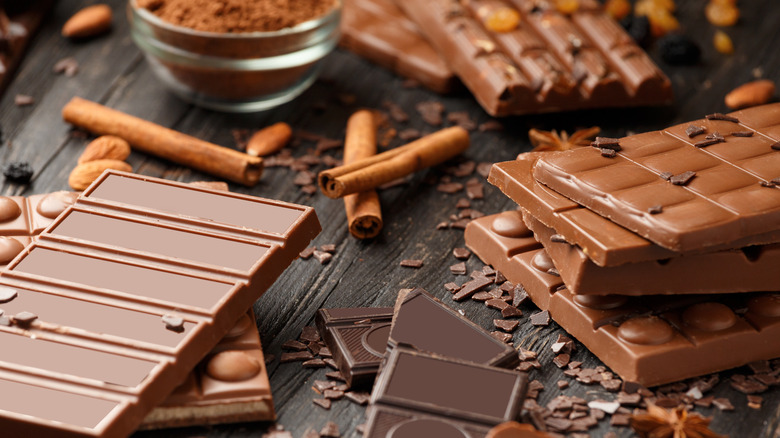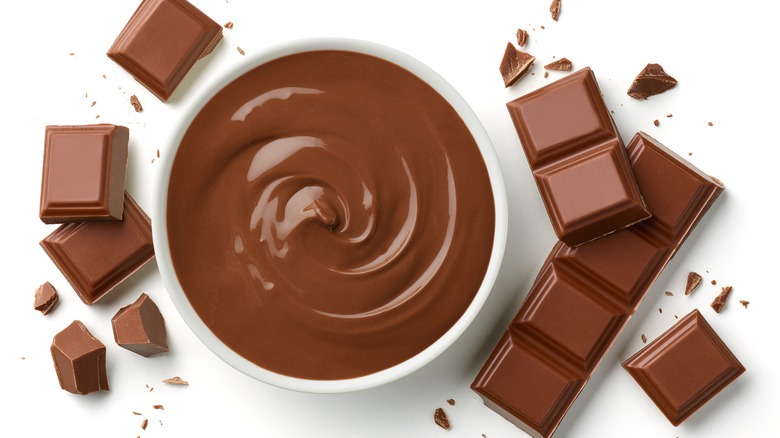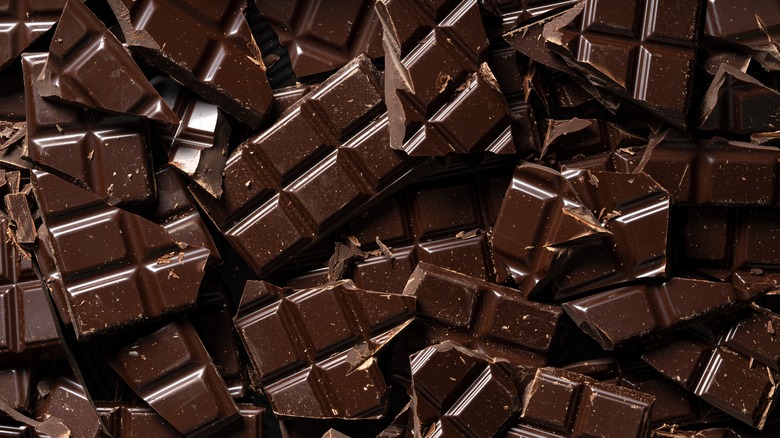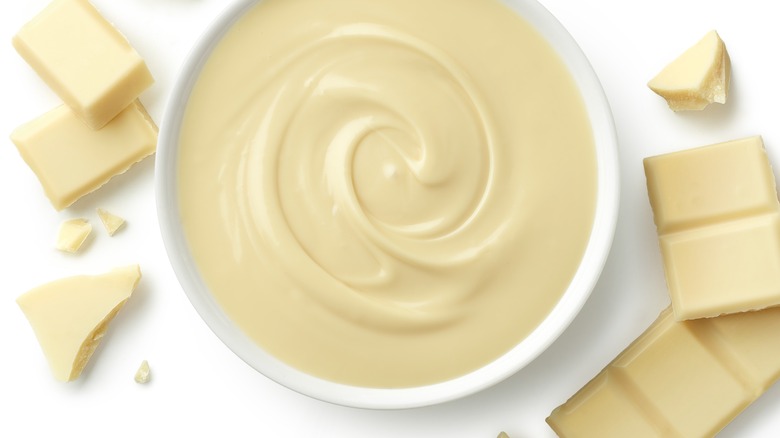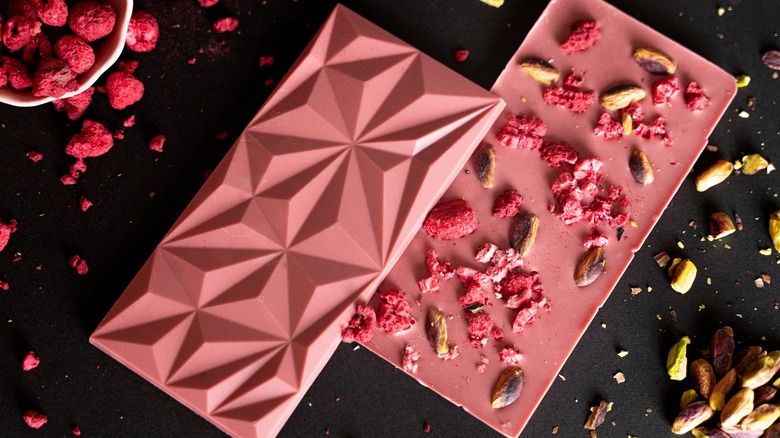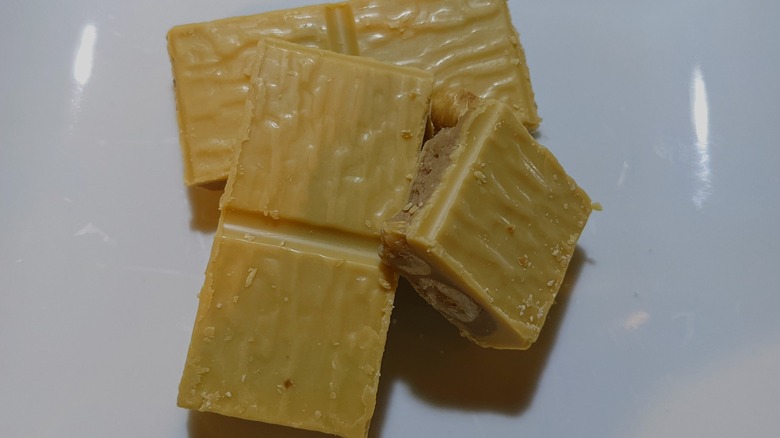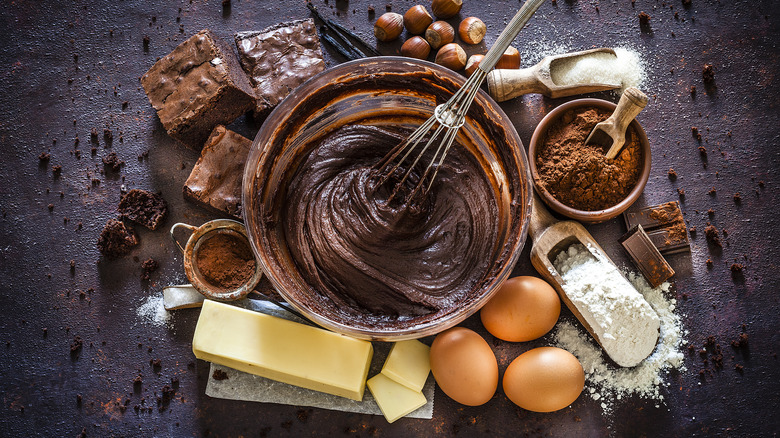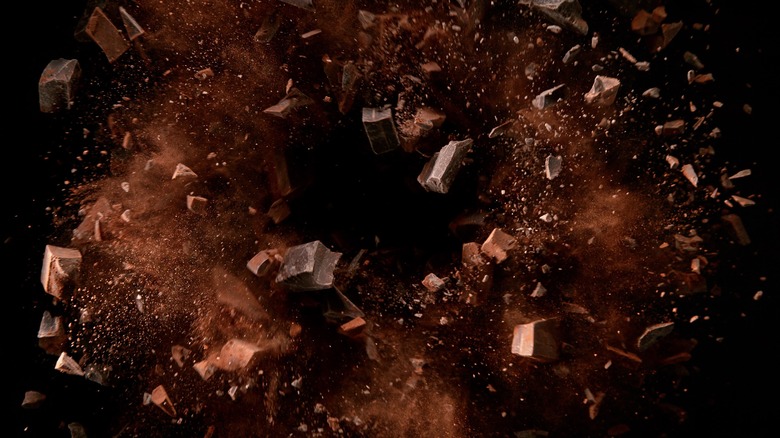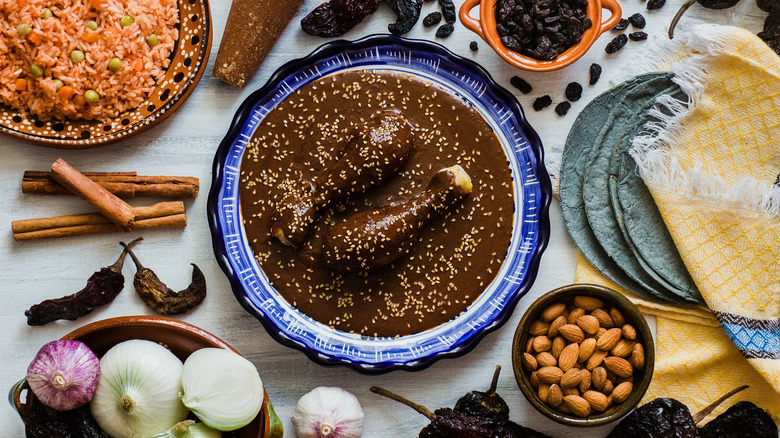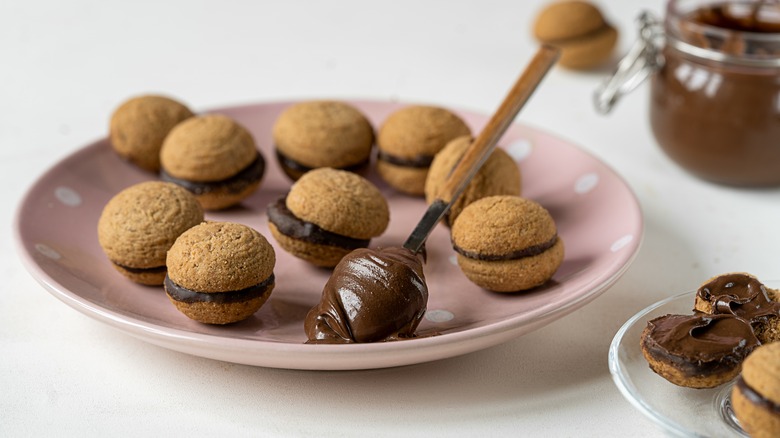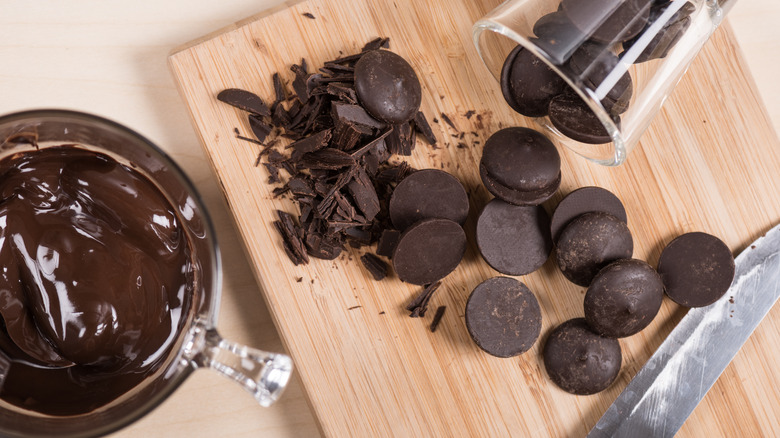10 Types Of Chocolate And How To Use Them
We may receive a commission on purchases made from links.
Whether cooking, baking, decorating, or hiding it from the kids for a midnight snack, chocolate is a favorite treat with a range of uses that goes beyond baking. It's also available in more forms and varieties than you might realize like chocolate bitters and crème de cacao for use in chocolate martinis, Mexican spiked hot chocolate, and frosty mudslides.
Chocolate was first developed in Mesoamerica approximately 5,300 years ago. The Olmec civilization first used the cacao plant to create a chocolate drink that was used in ceremonies and as medicine. Even the Aztec king Montezuma is said to have drank 50 cups a day out of a golden goblet. Now, that's some serious chocoholic vibes right there. Whether you're baking cookies, cakes, and truffles with dark and milk chocolate, making a mocha, whipping up mousse, mole, a ganache with couverture, Gianduja, or Mexican chocolate, it's helpful to know all the options for choosing the perfect type of chocolate to use in a recipe.
Chocolate is classified according to the proportions of cocoa and fat content used in the formulation. The flavor depends upon how much of the cocoa bean goes into the concoction in comparison to the other ingredients. We can thank countries like Switzerland, France, Belgium, Germany, Mexico, and Italy for adding their culinary expertise to elevate chocolate to gourmet proportions. The Mayans considered it a gift from the gods. We think they had the right idea.
1. Milk Chocolate
Made with a blend of cocoa butter, milk, and sugar, milk chocolate is one of the most popular types of chocolate you'll come across. This type contains smaller amounts of cocoa solids than the dark chocolate variety. It does have to contain at least 12 % milk to be called milk chocolate, hence the name. Milk chocolate is used in desserts, candy bars, pastries, and more.
Daniel Peter, a Swiss chocolatier, is credited with inventing milk chocolate in 1876. He added dried milk powder to the chocolate, thus creating chocolate milk. Many years later, he worked with a now-famous name, Henri Nestlé to bring this bold discovery to the world. And the world has never been more grateful for this collaboration.
To enjoy milk chocolate in all its glory, combine it with salty or savory flavors. A chocolate tart topped with crushed pretzel pieces is a wonderful mix of flavors and textures. Bake up a chocolate and peanut butter layer cake filled with almonds and peanuts for crunch. You can also blend a frothy mixture of milk, coffee, and milk chocolate (syrup or melted chocolate) for a rich caffé mocha or Milanese barbajada.
2. Dark Chocolate
A second favorite in the world of sweet treats, dark chocolate contains 50 to 90% cocoa solids, as well as a blend of cocoa butter and sugar. The more cocoa solids involved, the more intensity of flavor and less sweetness. That's why a dark chocolate bar with 70% cacao is going to be less intense and bitter-tasting than one with 86% cacao. Dark chocolate doesn't typically contain milk but does contain flavonoids, which are believed to help reduce inflammation and lower blood pressure.
If you like your chocolate nearer the bitter end of the sweetness scale, dark chocolate is the way to go. Use it to add a unique touch to chocolate chip cookies, shaved into curls and topped on German chocolate cake, chopped into a crunchy trail mix, or melted as a dipping sauce for strawberries, marshmallows, and even pineapple chunks. Dark chocolate makes a wonderful ganache for filling bonbons and tarts or decorating pastries and topping cupcakes.
3. White Chocolate
White chocolate has an incredibly creamy texture and sweet flavor profile. It's made from cocoa butter, sugar, and milk. Nestlé is credited for inventing white chocolate in the 1930s in Switzerland after experimenting to find a more appealing coating for kids' medications. See, we knew it was medicinal.
White chocolate was originally known as a confectionary coating due to the U.S. FDA's requirement that chocolate contain chocolate liquor, which is what gives chocolate its deep rich color. Eventually, that rule was amended to include white chocolate as a valid term. To be considered white chocolate, it must contain no less than 20% cocoa butter, no less than 14% milk solids, no less than 3.5% milkfat, and no more than 55% sugar. Interestingly, white chocolate doesn't contain any caffeine, as opposed to dark and milk chocolate, which have 12 milligrams (per 1 ounce), and 9 milligrams (per 1.55 ounces), respectively.
While some may find white chocolate to be overwhelming sweet on its own, it makes an excellent choice for dipped strawberries, as a ganache for filled tarts, buttercream cake layers, and in white-hot chocolate.
4. Ruby Chocolate
Ruby chocolate is a unique and naturally pink-tinged variety that comes from the ruby cocoa bean, which is grown in Ecuador, Brazil, and the Ivory Coast. It's made from 47.5 % cacao content and 26.3 % milk. Brought into mainstream chocolate production by Barry Callebaut, a Belgian chocolate maker, ruby chocolate features an incredibly smooth taste and a blend of fruity and sour notes. Its smooth consistency is like white chocolate without being overwhelmingly sweet.
Ruby chocolate adds a unique flavor to blondies, which can be achieved by using ruby chocolate instead of the white variety. It gives a wonderful berry flavor to cheesecake and éclair glaze. Whip up a batch of pastel pink ruby chocolate chip, crinkle, or sugar cookies for the next baby or bridal shower. Dip shortbread cookies into melted ruby chocolate for a fun dessert tray. A dusting of pastel sprinkles adds an extra festive touch.
Ruby chocolate also makes a wonderful accompaniment to cheese and chocolate pairings, dipped strawberries, and wine-tasting sessions. Buy ruby chocolate products from brands like Charles Chocolates, Chocolove, and Callebaut.
5. Blonde Chocolate
Fairly new to the world, blonde chocolate is a delicious and creamy accidental addition to the chocolate world. In the early 2000s, pastry chef Frédéric Bau accidentally left a batch of white chocolate in a double boiler. This caused the chocolate to undergo a process called the Maillard reaction, which is similar to caramelization. It gave the white chocolate a beautiful pale caramel color and upped the flavor with hints of butterscotch, shortbread, caramel, and toffee, like the flavor of dulce de leche. Essentially, Blonde chocolate is a white chocolate that's been cooked at a low temperature for a long time.
Use blonde chocolate in almost any recipe that calls for white chocolate. It will have a stronger flavor and a darker color, but that can also be a bonus. Caramel and chocolate. Yum! Frosting made with blonde chocolate will yield a caramel-inspired chocolate flavor when paired with German chocolate, devil's food, or even a light and fluffy angel food cake. Buy blonde chocolate from Ragusa and Valrhona to make rich and creamy brownies/blondies and shortbread cookies.
6. Baking Chocolate
Also known as chocolate liquor, baking chocolate is unsweetened chocolate. Sugar is added to the recipe. It's not to be confused with chocolate liqueur, which is a chocolate-flavored alcoholic beverage. Chocolate liquor doesn't contain any alcohol and is the base for dark and milk chocolate. It can add a rich touch to coffee, ice cream, and candy. Made from the nibs of cocoa beans, it's the magical ingredient that gives chocolate its wonderful taste and texture.
Baking chocolate is produced when the cocoa bean is roasted and fermented. At this point, the kernels can be ground into a paste, which is poured into a mold and hardened, resulting in bitter-tasting baking chocolate. Kernels can also be pressed, ground into a powder, or mixed with sugar and cocoa butter. It needs to be mixed with other ingredients, such as sugar, to create dark and milk chocolate.
Baking chocolate should only be used in recipes that call for baking chocolate, as the recipe will likely have considered the sugar factor. If baking chocolate is used for something like a ganache, which is quite sweet, you could end up with a very bitter frosting or filling.
7. Raw Chocolate
Raw chocolate is made from unroasted fermented cocoa beans. It contains natural sweeteners and no processed sugars. This is chocolate in one of its purest forms. It's believed to contain more vitamins, minerals, and antioxidants than dark chocolate since it goes through less processing. Raw chocolate has a cocoa percentage of 100%, meaning it's incredibly bitter so you'll want to use some sort of a sweetener when working with it in the kitchen. It comes in balls, pastes, and powder form from brands such as Navitas Organics and Antler Farms.
In addition to being used in vegan candy bars, raw chocolate can be mixed into fruit bowls and overnight oats, blended with peanut butter and nuts for raw chocolate bowls, and used in smoothies, brownies, hot chocolate, desserts, and many other items.
Combine raw chocolate powder with garbanzo beans, tahini, and a bit of vanilla for a creamy hummus. Maple syrup adds a nice touch of sweetness. This decadent dip is wonderful for dipping fruit, crackers, naan, rice cakes, and toast.
8. Mexican Chocolate
Mexican chocolate is a paste that's made from sugar, cinnamon, and cocoa nibs. Other flavors like vanilla, nutmeg, and chilis can be mixed into it. Dried cocoa beans are cracked open revealing the small nibs inside. These nibs are ground and roasted and then poured into a mold and sold in stores as a solid disc to make Mexican chocolate. Brands include Abuelita, Oaxacanita Chocolate, and Taza Chocolate.
The texture of Mexican chocolate is grainy due to its high sugar content and a slight, but not overpowering, bitter taste with a hint of spicy cinnamon. When mixed in with hot steamed milk or whipped into a chocolate bread pudding, you'll never notice the texture. Just that rich, creamy, and decadent flavor.
Mexican chocolate, unlike most dessert chocolates, is used as an ingredient in recipes to complement other foods. Use it to make Mexican hot chocolate, mole sauce, beef or pork chili, and sweet tamales. Mexican chocolate adds unique flavors and depth to red pozole, a Mexican stew that combines pork, hominy, dried chilis, and a flavor-filled array of spices.
9. Gianduja Chocolate
Hailing from Turin during the times of Napoleon, Gianduja (jaan·DOO·yuh) chocolates feature sugar, cocoa, and between 20 to 40% ground hazelnuts. It can also contain crushed almonds or walnuts. The cocoa beans and the hazelnuts are roasted separately before being blended and ground down. With the high percentage of hazelnuts, Gianduja chocolate health benefits start to add up. Hazelnuts are a great source of vitamin E, copper, manganese, omega-6, and omega-9.
Gianduja is divided up into three categories: dark, milk, and light. Dark hazelnut Gianduja has a 28% cocoa content and does not contain milk. Milk Gianduja chocolate has a mixture of cocoa and a 13% milk content. The light variety has the highest sugar and nut content at 50%.
Similar to Nutella in taste, Gianduja chocolate is used in mousses, cakes, bars, and as a ganache in decadent chocolate treats like bonbons, truffles, macarons, and lady's kisses. Melt it and drizzle over toast, waffles, and fruit. Valrhona, Venchi, and La Torinese are a couple of Gianduja chocolate brands to try.
10. Couverture Chocolate
A confectionary chocolate, couverture has a higher percentage of cocoa butter than typical chocolates, which gives it a smooth texture and a glossy sheen, which also comes from the fact that it's ground to a finer texture during the production process. It also melts easier than most chocolates. Couverture can be found in delicious flavors ranging from milk and dark chocolate to ruby, white, and caramel in various shapes and sizes.
Couverture, French for "to cover," is used as a garnish in baking and fillings for truffles, bonbons, and other culinary creations. Since the added cocoa butter allows it to melt and temper better and faster, couverture is a wonderful choice for coating pastries and dipping desserts like chocolate-covered strawberries, cheeses, and crackers. It's a good option for molten chocolate cakes, hot chocolate bombs, and amaretto triangle drizzles. Couverture can be purchased from brands like Callebaut, Cambie, and Guittard.
